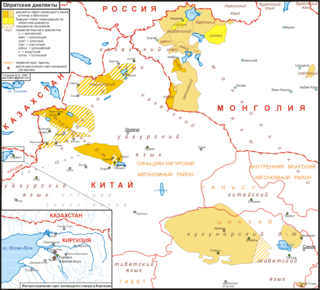Related Research Articles

The Mongols are an East Asian ethnic group native to Mongolia, Inner Mongolia in China, and the Buryatia Republic of the Russian Federation. The Mongols are the principal member of the large family of Mongolic peoples. The Oirats in Western Mongolia as well as the Buryats and Kalmyks of Russia are classified either as distinct ethno-linguistic groups or subgroups of Mongols.

Mongolian is the principal language of the Mongolic language family that originated in the Mongolian Plateau. It is spoken by ethnic Mongols and other closely related Mongolic peoples who are native to modern Mongolia and surrounding parts of East and North Asia. Mongolian is the official language of Mongolia and Inner Mongolia and a recognized language of Xinjiang and Qinghai.

The Mongolic languages are a language family spoken by the Mongolic peoples in Eastern Europe, Central Asia, North Asia and East Asia, mostly in Mongolia and surrounding areas and in Kalmykia and Buryatia. The best-known member of this language family, Mongolian, is the primary language of most of the residents of Mongolia and the Mongol residents of Inner Mongolia, with an estimated 5.7+ million speakers.

Oirats or Oirds, also formerly Eluts and Eleuths, are the westernmost group of the Mongols whose ancestral home is in the Altai region of Siberia, Xinjiang and western Mongolia.

Oirat is a Mongolic language spoken by the descendants of Oirat Mongols, now forming parts of Mongols in China, Kalmyks in Russia and Mongolians. Largely mutually intelligible to other core Central Mongolic languages, scholars differ as to whether they regard Oirat as a distinct language or a major dialect of the Mongolian language. Oirat-speaking areas are scattered across the far west of Mongolia, the northwest of China and Russia's Caspian coast, where its major variety is Kalmyk. In China, it is spoken mainly in Xinjiang, but also among the Deed Mongol of Qinghai and Subei County in Gansu.
Classical Mongolian was the literary language of Mongolian that was first introduced shortly after 1600, when Ligdan Khan set his clergy the task of translating the whole of the Tibetan Buddhist canon, consisting of the Kangyur and Tengyur, into Mongolian. This script then became the established literary language used for all Mongolian literature since its introduction, until the 1930s when the Mongolian Latin alphabet was introduced, which then in 1941 was replaced by the Mongolian Cyrillic alphabet.

Pan-Mongolism is an irredentist idea that advocates cultural and political solidarity of Mongols. The proposed territory, called "Greater Mongolia" or "Whole Mongolia" usually includes the independent state of Mongolia, the Chinese region of Inner Mongolia, and the Russian region of Buryatia. Sometimes the autonomous republic Tuva, the Altai Republic and parts of Xinjiang, Zabaykalsky Krai, and Irkutsk Oblast are included as well. As of 2006, all areas in Greater Mongolia except Mongolia have non-Mongol majorities.
Middle Mongol or Middle Mongolian was a Mongolic koiné language spoken in the Mongol Empire. Originating from Genghis Khan's home region of Northeastern Mongolia, it diversified into several Mongolic languages after the collapse of the empire. In comparison to Modern Mongolian, it is known to have had no long vowels, different vowel harmony and verbal systems and a slightly different case system.
I is a letter of related and vertically oriented alphabets used to write Mongolic and Tungusic languages.
O is a letter of related and vertically oriented alphabets used to write Mongolic and Tungusic languages.
U is a letter of related and vertically oriented alphabets used to write Mongolic and Tungusic languages.
Oe is a letter of related and vertically oriented alphabets used to write Mongolic and Tungusic languages.
Pa is a letter of related and vertically oriented alphabets used to write Mongolic and Tungusic languages.
Qa is a letter of related and vertically oriented alphabets used to write Mongolic and Tungusic languages.
Ga is a letter of related and vertically oriented alphabets used to write Mongolic and Tungusic languages.
Sa is a letter of related and vertically oriented alphabets used to write Mongolic and Tungusic languages.
Ja is a letter of related and vertically oriented alphabets used to write Mongolic and Tungusic languages.
Ya is a letter of related and vertically oriented alphabets used to write Mongolic and Tungusic languages.

This article describes two- and three-letter combinations used for the Mongolian language when written in the Mongolian script.
References
- Kotkin, Stephen (1999). "In Search of the Mongols and Mongolia: a multinational odyssey". Mongolia in the Twentieth Century: Landlocked Cosmopolitan. M.E. Sharpe. ISBN 9780765605368.
- Uradyn E. Bulag (2005). "Where is East Asia? Central Asian and Inner Asian Perspectives on Regionalism" (PDF). Japan Focus: The Asia Pacific Journal. 3 (10).
- Polyanskaya, O. N. (2011). "Монголоведение в университетах России в XIXначале XX вв. Восточный институт во Владивостоке" [Mongolian Studies in Universities of Russia in the 19th and at the Beginning of 20th Centuries. Oriental Institute in Vladivostok]. Гуманитарный вектор (3).
- Janhunen, Juha (2012). "Mongolian Studies in the Nordic Countries: A Brief Historical Survey" (PDF). Journal of the Center for Northern Humanities. 5: 43–55.
- Tsai Wei-chieh (2012). "The Current Trends of Mongolian Studies in the U.S.A" (PDF). Mongolian and Tibetan Quarterly. 21 (3). Archived from the original (PDF) on 2016-10-12. Retrieved 2016-10-05.
- Nalin (2012). "A Brief Introduction to Mongolian Studies in Mainland China" (PDF). Mongolian and Tibetan Quarterly. 21 (4). Archived from the original (PDF) on 2016-10-12. Retrieved 2016-09-22.
- Polyanskaya, O. N. (2014). "At the origins of Mongolian studies in Russia: Isaac Jacob Schmidt and Józef Kowalewski". Mongolica. XVII.
- Bawden, [Charles R.] (2013). Mongolian Literature Anthology. Routledge. ISBN 9781136602627.